Wen-Ying Tsai
| Wen-Ying Tsai | |
|---|---|
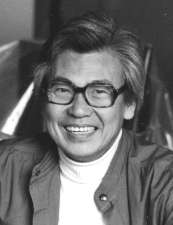 Tsai in the 1970s. | |
| Born |
Wen-Ying Tsai October 13, 1928 Xiamen, China |
| Died |
January 2, 2013 (aged 84)[1] Manhattan, New York City |
| Nationality | American |
| Education | University of Michigan, Art Students League, New School for Social Research. |
| Known for | Sculpture, Cybernetic art, Kinetic art, Interactive art |
| Notable work | US Patent #4,265,402 (for Upward Falling Fountain); Japan Patent #1299159 (for Strobe Liquid Display Device) |
| Movement | Art, Science, and Technology |
| Awards |
John Hay Whitney Fellowship for Painting, 1963 Edward MacDowell Fellowship, 1965 Second Prize, Experiments in Art and Technology (E.A.T.), Museum of Modern Art, New York, 1968 Fellow, Center for Advanced Visual Studies, Massachusetts Institute of Technology, 1969 Best Fine Art in Steel, American Iron and Steel Institute, 1971 ARTEC Grand Prix, Second International Biennale, Nagoya, Japan, 1991 Alumni Merit Award, University of Michigan, 2001. |
| Patron(s) | Howard Wise Gallery, Denise René Gallery, David Bermant Foundation |
Wen-Ying Tsai (October 13, 1928 – January 2, 2013) was an American pioneer cybernetic sculptor and kinetic artist best known for creating sculptures using electric motors, stainless steel rods, stroboscopic light, and audio feedback control. As one of the first Chinese-born artists to achieve international recognition in the 1960s, Tsai was an inspiration to generations of Chinese artists around the world.[2]
Biography

Wen-Ying Tsai was born in Xiamen, Fujian Province, China and emigrated to the United States in 1950, where he attended the University of Michigan, receiving a Bachelors in Mechanical Engineering (BSME) in 1953. Moving to New York City after graduation, Tsai embarked on a successful career as an architectural engineer working for clients such as Walter Gropius, Mies van der Rohe, Synergetics, and Skidmore, Owings and Merrill.[3] While working as an engineer by day, Tsai pursued artistic studies at the Art Students League at night, while also taking courses in political science and economics at the New School for Social Research. Tsai also attended modern dance classes with Erick Hawkins.
In 1963, Tsai won a John Hay Whitney Fellowship for Painting, after which he decided to leave engineering and devote full-time to the arts. After a three-month trip in Europe, he returned to New York and began to make three-dimensional constructions using optical effects, fluorescent paints, and ultra-violet light. These wary works were later selected for The Responsive Eye, an exhibition curated by William Seitz at the Museum of Modern Art in New York.
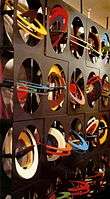
Unsatisfied with his static sculptures, Tsai began to introduce movement using motors. He created Multi-kinetic Wall in 1965, which was exhibited in Art Turned On at the Institute of Contemporary Art, Boston. Art historian Sam Hunter described the work:
Tsai's Multi-kinetics were dynamically integrated multiple constructions, employing thirty-two kinetic units, each of which contains a configuration of multi-colored gyroscopic forms. With these elements he created an active environmental field that could, apparently, be infinitely extended. Each motorized unit was a self-sufficient entity, and when it was combined with other similar units produced a large-scale kinetic work that joined visual intensity with mechanical power. By controlling the time sequence of each unit in skillful compositions, Tsai used engineering principles to achieve aesthetic ends."[4]
But it was ultimately during a fellowship at the Edward MacDowell Colony in 1965 that Tsai had his "Eureka!" moment. While contemplating the sunlight shimmering in the trees, he had a sudden insight to use his engineering background to create art work that replicates natural phenomena. Finding a starting point in the work of constructivist artist Naum Gabo, Tsai took a quantum leap deciding that "the shimmering was not enough" and that what was needed was a way that the viewer could interact with the work. It was that inspiration that eventually lead him to the idea to use a stroboscope coupled with a feedback control system.[5]
Sam Hunter writes:
For the next three years, Tsai worked steadily toward his new goals. His first "feedback" pieces were shown in an important and original show in 1968 at the Howard Wise Gallery in New York, an exhibition called "Cybernetic Sculpture." In the same year, Tsai's "Cybernetic Sculpture System No.1" won the second prize in an E.A.T. competition, and was selected by Pontus Hulten, the guest curator, for his mammoth international exhibition entitled "Machine as seen at the End of the Mechanical Age" held at the Museum of Modern Art in New York.[6]
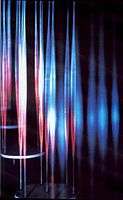
During this time, along with international friends including Takis, Tsai was a founding member of the Art Workers' Coalition that sought to implement museum reform and underscore "issues relating to the political and social responsibility of the art community."
In 1969, Tsai was invited by György Kepes to the Center for Advanced Visual Studies at MIT. There, amongst the "first Fellows", a lively group of like-minded artists (including Jack Burnham, Otto Piene, Takis, Harold Tovish, Stan VanDerBeek), Tsai met Harold "Doc" Edgerton, the engineer who developed the modern electronic stroboscope.
In the early 1970s, Tsai moved with his family to Paris and showed with the Denise René Gallery and had extensive exhibitions in Europe. During these years, he befriended fellow Chinese artists residing in Paris including Peng Wants and Chu Teh-Chun and became very passionate about cultural exchange between China and the West. In 1979, Tsai and his friend the composer Wen-chung Chou were part of the first delegation of artists from the US to the People's Republic of China.[7] This eventually lead Tsai and his wife Pei-De to establish The Committee for Chinese Artists Intercultural Movement (CCAIM), a pioneering non-profit organization that brought mainland Chinese artists to exhibit in the United States in the 1980s. After Paris, Tsai settled permanently in New York City. From his base in SoHo, Tsai expanded his exhibitions to Asia—Hong Kong, Singapore, Taipei, Nagoya, Beijing. In 2006, Tsai and Pei-De established the Tsai Art and Science Foundation to support and bring awareness to endeavors that are at the intersection of the arts and sciences.
Works
Tsai's cybernetic sculpture works have always been a challenge for writers to describe. Art critic Robert Hughes evokes them vividly:
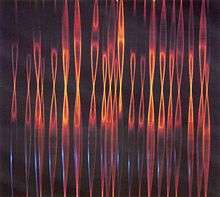
A grove of slender stainless-steel rods rises from a plate. This vase vibrates at 30 cycles per second; the rods flex rapidly, in harmonic curves. Set in a dark room, they are lit by strobes. The pulse of the flashing lights varies--they are connected to sound and proximity sensors. The result is that when one approaches a Tsai or makes a noise in its vicinity, the thing responds. The rods appear to move; there is a shimmering, a flashing, an eerie ballet of metal, whose apparent movements range from stillness to jittering, and back to a slow, indescribably sensuous undulation.[8]
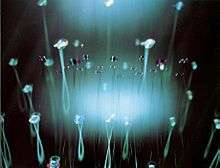
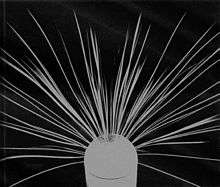

The philosopher Vilem Flusser writes of Tsai's work:
There can be no doubt that Tsai's phenomena (whether they be works of art in the strict sense, or whether they be fantastic artifices) are extremely important. They show what promises and dangers may be in here in a "play," if it is proposed by a great artist. Because, even if Tsai's phenomena be considered artifices, there can be no doubt that Tsai is a great artist. Not because what he does is pleasant, or because he proposes a play, or because he represents the spirit of our times, but because he reveals to us, through artifice or works of art, the concrete experience of a future full of promise or abysmal danger.[9]
Tsai's interactive sculpture marked a major step in the development of kinetic art:
A major portion of luminist and kinetic art originated in Europe, beginning with the formation in 1960 of GRAV (Groupe de Recherche d’Art Visuel) by eleven artists of different nationalities, all resident in Paris. Wen-Ying Tsai is an [American] associate who showed with that group at the Galerie Denise Rene, which made its reputation on technology art. Tsai is a Chinese-born sculptor now living in New York. The slender, stainless steel “cybernetic” rods of his sculpture vibrate in different patterns in response to electronic impulses, to the clapping of human hands, or to the flashes of a strobe light. In the artist’s words, they are designed to simulate “the intensity of a living creature.” While the contemporary interest in light and kinetic sculpture is in a sense traditional, and dates back at least to Naum Gabo, to Marcel Duchamp, Moholy-Nagy and the Bauhaus, only in the postwar era has the artist tried consciously to use available computer and electronic technology to create robot works of art which can be activated environmentally.[10]
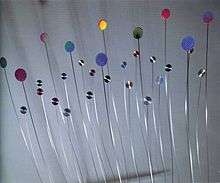
Frank Popper elaborates:
As far as the sensory experience of the spectator goes, the most outstanding American kinetic artist is unquestionably the Chinese-born Wen-Ying Tsai. His pieces, which are perfect on the technological level, serve the primary purpose of giving a complete visual experience to the spectator, whose sound solicitations provoke a choreographic, chromatic and rhythmic response in the ‘cybernetic sculptures’. [...]György Kepes has commented enthusiastically on the ‘magic rhythms emanating from this swaying, dancing steel trembling with life’, and he has also noted the sense of ‘an instant fellowship, a spontaneous celebration’ which is re-created in their presence. As he concludes: ‘Rhythm is friendship and in Tsai’s work there is friendship of light, sound and our own heart-beats.’
If this appraisal testifies to the success with which Tsai affects the sensory and emotional responses of the spectator, we must not neglect the fact that he is also addressing himself to reason and the scientific element in his audience. In effect, the observer can enter an almost mathematical relationship with these works, and sharpen his perceptual powers through the exact assessment of the various aesthetic parameters of vibration, sound, colour, wave movement, etc.[11]


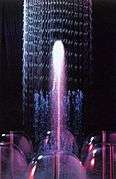
Richard Kostelanetz writes about Tsai's cybernetic water works:
Of his other kinetic sculptures, Upward-Falling Fountain (1979) is the most impressive, creating an illusion that must be seen to be believed. As the water falling from a vibrating shower head is illuminated by a strobe, the droplets are caught dancing in response to sound; at certain strobe speeds, the droplets appear to be moving upwards, violating all rules of gravity. Living Fountain (1980-88) is a yet larger water sculpture, incorporating a showerhead three feet in diameter, plus three concentric circles of water jets, all installed above a basin twelve by sixteen feet. Here the strobe is designed to respond to combinations of changes in audible music, random sensors, audio-feedback controls, and a computer program.[12]
In conclusion, Frank Popper writes in his "Electra" exhibition catalog about Tsai's essential contribution:
The role played by Tsai, the American artist of Chinese origin, in this context cannot be overestimated, in his most varied cybernetic sculptures in the Electra exhibition are perfect examples of an artistic comment, perhaps an artistic solution to one of the principal problems raised in this show: the situation of the artist between technology, at a critical point of its passage from the mechanical to the electronic era, and man's natural or artificial environment...This transition from the stage of the electro-mechanical period and its art to the electronic era with its cultural manifestations is accompanied by a new assessment of the machine. If Oswald Sprengler rebelled against the fact the "lord of the world" became the slave of the machine, that civilization itself has become a machine which does everything mechanically, George Friedmann has observed that the worker has stopped being the servant of the machine to become its overseer. It is up to man's
political intelligence, and to his intelligence alone, to decide to what ends he will use the power put at his disposal.[13]
East and West
Vilem Flusser's analysis of Tsai's work delves into his place in both the Eastern and Western traditions.
Possibly Tsai himself does not stand within Western tradition. The analysis of his phenomena seems to reveal this. In that case the arguments just advanced cannot touch him. Possibly he stands within an Oriental tradition, for which (so at least it looks like to a Western observer) man is not a being radically separated form all others. For such a tradition man may feel deeply united with animals, plants, and other types of beings. He can therefore, conceive of them much more as "others" than we can. And the phenomena Tsai produces are then, in their naive, plant-like Gestalten, "true others" If I can dialogue with a plant (and Oriental tradition seems to suggest this), then a fortiori, I can dialogue with the phenomena Tsai is producing. Such an hypothesis of Tsai's position would explain his approach to the problem posed by the series "thing-other." He could then still see others (even in a stone), where we no longer can see them. In this case Tsai may say that his is an important Oriental contribution to the Western (and bankrupt) attempt to free man from the determining effects of objects of culture. He may say that he is using Western models and Western methods from an Oriental approach, in order to try and solve the universally human problem of freedom from determination. And he will be completely correct in thus answering the above advanced objections.[14]
Tsai and Taoism
Art historian Donald Kuspit finds in Tsai's art a Taoist outlook:
Previous discussions of Tsai's work have concentrated on its technology and its place in the development of modern art/ I want to concentrate on its Weltanschauung or inner point of view, which has been completely neglected in every discussion, not doubt because it transcends modernity, indeed, subverts it by subsuming it. Tsai's ultramodern technology is a means of expressing a consistent, fundamental attitude to life, which his cybernetic sculptures literally embody. Without the understanding of this attitude, they make only technological sense. With the understanding of his Weltanschauung, which I think is Taoist, his sculptures make extraordinary emotional sense. Indeed, they quintessentialize the Taoist attitude to nature, and offer it as a model for psychic health. [...] And it is no accident that Tsai emphasizes the "healthful" use of engineering, remarking that "the danger for the engineer is to have no feeling for humanity because of his limited and specialized training. Tsai is an engineer - a very inventive, paradoxical one, as his 1981 patent for an upward falling fountain indicates - but he is also an artist, that is, a person of feeling, indeed, a visionary of feeling. His work fuses art and engineering in a synthesis made all the more unique by its Taoist underpinnings - the Taoist conviction that subliminally informs it. The attempt to unite opposites motivates all ofTsai's work. It is evident from the start, in the conception of the work, and the structure that results from the conception, and in the perceptual and emotional experience that are its human - one should say humane, therapeutic - goal.[15]
Personal life
Tsai met his wife, Pei-De Chang, in New York City in 1967. They were married in London in 1968 during the Cybernetic Serendipity exhibition in which Tsai participated. The couple had twin sons two years later when Tsai was a Fellow at the Center for Advanced Visual Studies at MIT; their friend Otto Piene is fond of recalling that the Tsais' twins were the first of the "Center babies."[16]
The Tsai family spent part of the 1970s in Paris before settling down permanently in SoHo, New York where they lived in a loft space that they renovated themselves. Richard Kostelanetz has written about the Tsais in SoHo in his book SoHo: The Rise and Fall of an Artists' Colony.[17]
Death
Tsai died at Mount Sinai Hospital in Manhattan, New York, on January 2, 2013, with his wife and sons at his bedside. He was survived by his wife Pei-De; sons and spouses Lun-Yi London (Michelle) and Ming-Yi Gyorgy (Marloes); grandchildren Sakhaya, Kelsyn, and Lina. Artist Otto Piene and composer Wen-chung Chou were among those who spoke at Tsai's funeral service.
Foundation
The Tsai Art and Science Foundation was established to continue the vision of cybernetic sculptor Wen-Ying Tsai to support and bring awareness to endeavours that are at the intersection of the arts and sciences. In addition to preserving the unique works of Wen-Ying Tsai for the enjoyment and scholarship of future generations, the Foundation will develop programming that will showcase contemporary artists and scientists whose work contribute not only to the understanding of both realms, but also to their critical interdependence, which exemplifies the spirit of Wen-Ying Tsai.
Future programming will take the form of exhibitions at the Foundation's centrally located space in downtown Manhattan; educational outreach to local schools; hosting events such as public dialogues and round-tables featuring artists and scientists; and facilitating the research and exhibition of Tsai's work around the world.
Collections
- Addison Gallery of American Art, Andover, Massachusetts
- Albright-Knox Art Gallery, Buffalo, New York
- Butler Institute of American Art, Youngstown, Ohio
- Centre Georges Pompidou, Paris
- Chrysler Museum of Art, Provincetown, Massachusetts
- David Bermant Foundation, California
- Franklin Institute, Philadelphia, Pennsylvania
- Great Explorations, St. Petersburgh, Florida
- Hayden Gallery, Massachusetts Institute of Technology
- Israel Museum, Jerusalem
- Kaiser Wilhelm Museum, Krefeld, Germany
- Kunsthalle Nuremberg, Germany
- Lannon Foundation, California
- Malcolm Forbes Foundation, New York
- Memorial Art Gallery, Rochester, New York
- Musée d'Art Moderne de la Ville de Paris
- Museo de Arte Contemporaneo de Caracas, Venezuela
- Museum für Holographie, Pulheim/Köln, Germany
- Princeton University Art Museum, Princeton University, New Jersey
- Museo de Bellas Artes, Caracas
- Nagoya City Art Museum, Nagoya, Japan
- Oklahoma Museum of Art, Oklahoma
- Ontario Science Center, Toronto
- Orlando Science Center, Orlando, Florida
- Science/Art Park, Kanagawa Prefecture
- Shirahama Energy Land, Matsushita Electric Co. (Panasonic), Tokyo
- Tate Gallery, London
- University of Alberta Museum, Canada
- Whitney Museum of American Art, New York City
Selected exhibitions
Solo
1961 Ruth Sherman Gallery, New York
1964 & 1965 Amel Gallery, New York
1968 Howard Wise Gallery, New York
1970 Alpha Gallery
Museum Haus Lange, Krefeld, Germany
1971 Hayden Gallery, Massachusetts Institute of Technology
Ontario Science Center, Toronto
Galérie Françoise Mayer, Brussels
University of Pittsburgh
Michael Berger Gallery, Pittsburgh, PA
1972 Galérie Denise René, Paris
Corcoran Gallery of Art, Washington, D.C.
Galérie Denise René, New York
1973 Galérie Denise René/Hans Mayer, Düsseldorf.
Musee d'Art Contemporain, Montreal.
1975 Museo de Arte Contemporaneo de Caracas, Venezuela.
1978 Wildenstein Art Center, Houston.
Museo de Bellas Artes, Caracas.
1979 Hong Kong Museum of Art.
1980 Isetan Museum of Art, Tokyo.
1983 Galerie Denise Rene, Paris.
1989 National Museum of History, Taipei.
1990 Taiwan Museum of Art, Taichung, Taiwan.
1997 National Museum of China, Beijing, China.
Group
1965
"The Responsive Eye," Museum of Modern Art, New York.
"The New Eyes," Chrysler Art Museum, Provincetown, Massachusetts
City Art Museum of St. Louis
"Art in Science," Albany Institute of History and Art
"Art Turned On," Institute of Contemporary Art, Boston.
"Art in Science," organized by Smithsonian Institution, Washington
D.C.
National Academy of Science, Washington, D.C.
1968
"Cybernetic Serendipity," Institute of Contemporary Arts,
London.
"The Machine as Seen at the End of the Mechanical Age"
Museum of Modern Art, New York.
1969
"Cybernetic Serendipity," Corcoran Gallery of Art,
Washington, D.C.
"Howard Lipman Collection," Whitney Museum of
American Art, New York.
"Master Pieces of Modern Art," Galerie Denise Rene/Hans
Mayer, Krefeld, Germany.
"Explorations," Hayden Gallery, Massachusetts Institute of
Technology
National Collection of Fine Arts, Smithsonian
Institution, Washington, D.C.
3e Salon International des Galeries Pilotes, Cantonal Museum of Fine Arts, Lausanne
Musee d'Art Moderne, Paris.
Pittsburgh International, Museum of Art, Carnegie Institute,
Pittsburgh.
"Struktur Schwingung Dynarnik," Kunsthalle, Nuremberg.
"L'Art et les Technologies," Ville de Vitry-sur-Seine, France.
"Multiple Interaction Team," Museum of Science and Industry,
Chicago
"Salon International des Composants Electroniques," Paris.
"Custom and Culture," US Custom House, New York.
"Art of the Space Era," Huntsville Museum of Art, Alabama.
"The Expanding Visual World," The Museum of Fun,
Asahi Shimbun, Tokyo.
1983
"Electra," Musee d'Art Moderne, Paris.
1984
"Carte Blanche Denise Rene." Paris.
1986
"Les Machines Sentimentales," Avignon.
"La Biennale Di Venezia," Venice.
"Energetic Art," La Malmaison, Cannes.
1987
"Artware, Kunst und Elektronik," Hanover International Fair.
"Artware," Düsseldorf Landsmuseum.
"Art in the Computer Age," Everson Museum of Art,
Syracuse, New York.
"Art in the Computer Age," Cincinnati Contemporary Art
Center, Cincinnati, Ohio.
1988
"Computers and Art," IBM Gallery of Science and Art,
New York.
"Lights OROT," Yeshiva University Museum, New York.
"Interaction," The Aldrich Museum of Contemporary Art,
Connecticut.
"Vraiment Faux," La Fondation Cartier, Jouey-en-Jossas,
France.
"Art Construit, Lumiere, Mouvement," EPAD, Galerie La
Defense, Paris.
"Art in the Computer Age," Center for the Fine Arts, Miami.
1989
"Phenomena Art," Pan-Asian Expo '89, Saibu Gas Museum,
Fukuoka, Japan.
KSP, Kawasaka - Kanagawa Prefecture.
"Visiona," Vienna Messe-WienerFestwochen.
"Visiona," Zurich.
1990
"Image du Futur," Montreal, Canada.
1991
"ARTEC '91, The International Biennale in Nagoya.Japan.
1995
"Kwangju International Biennale" in Korea.
"Osaka Triennale 1995" - Sculpture.
2001
"Denise René, l'intrépide," Centre Georges Pompidou, Paris
2008
"Olympic Games, 2008," Beijing
2010
"Expo 2010 Shanghai," Shanghai Art Museum, Shanghai
References
- ↑ Wen-Ying Tsai Obituary, legacy.com, January 5, 2013
- ↑ Shao Dazhen, Perfect Union of Art, Science and Technology: the cybernetic sculpture of Tsai Wen-Ying, Cybernetic Sculptures: the world of Tsai Wen-Ying, exhibition catalog, National Art Museum of China, Beijing, 1997, p. 157
- ↑ Joann Cerrito, Editor, Contemporary Artists, St. James Press, 1993, p. 1183
- ↑ Sam Hunter, The Cybernetic Sculpture of Tsai Wen-Ying, exhibition catalogue, National Museum of History, Taipei, 1989, p. 66-67
- ↑ Sam Hunter, The Cybernetic Sculpture of Tsai Wen-Ying, exhibition catalogue, National Museum of History, Taipei, 1989, p. 67:
He had come there dissatisfied with his work, even though his multi-kinetic work was admired and winning him professional recognition. However, at that moment, other ideas were gestating and he wanted to add what he called a "fifth dimension" to his art - that of artificial intelligence. [...]
[At the colony,] he was able to turn his thoughts inward, hoping to discover the new methods and direction that would more deeply satisfy his creative needs. It was at this point, while watching the motions and patterns of sun on leaves in the New Hampshire woods one morning, that Tsai finally achieved the revelatory breakthrough that changed his art and liberated his creative energies. As he put it, he wanted to create "natural movements in dynamic equilibrium, with intelligence," and he found his solution in an unlikely combination of natural phenomenon, the precedent of Gabo's singular (and unrepeated) kinetic sculpture, and the new resource of contemporary analog and digital technology.
Speaking of this moment of revelation, Tsai said that he had quite deliberately turned himself into "a sort of plant": facing his chair into the sunshine in the morning, he turned his body in stages throughout the day, mulling over ways of make an "art that presented the observer with natural movements in dynamic equilibrium, and art that could convey the awe I felt while watching sunbeams shimmer through forest leaves." But a work that would "shimmer" simply did not do enough either for the artist or viewer, Tsai concluded. It must also respond in some way to the observer; it would have to work on a new feedback principle and actually engage the observer directly. In short, a cybernetic sculpture was required. To create such radically participatory works, he understood, would require that he draw on his engineering skills rather than suppress them, as he had been trying to do in his period of oil painting. - ↑ Sam Hunter, The Cybernetic Sculpture of Tsai Wen-Ying, exhibition catalogue, National Museum of History, Taipei, 1989, p. 67
- ↑ Shao Dazhen, p. 157
- ↑ Robert Hughes, Shaped by Strobe, Time, October 2, 1972
- ↑ Vilem Flusser, Aspects and Prospects of Tsai's Work, Art International, March 1974
- ↑ Brown, Hunter, Jacobus, Rosenblum, and Sokol, American Art, Abrams, 1979, p. 585
- ↑ Frank Popper, Art--Action and Participation, New York University Press, 1975, p. 214
- ↑ Richard Kostelanetz, Dictionary of the Avant-Gardes, Second Edition, Routledge, 2001, pp. 621-622.
- ↑ Frank Popper, L'électricite et L'électronique dans l'art au XXe siècle, Electra, exhibition catalogue, Musée d'Art Moderne de la Ville de Paris, Paris, 1983, unpaginated.
- ↑ Vilem Flusser, Aspects and Prospects of Tsai's Work, Art International, March 1974
- ↑ Donald Kuspit, Tsai's Cybernetic Vision: technology in the service of the Tao, Cybernetic Sculptures: the world of Tsai Wen-Ying, exhibition catalog, National Art Museum of China, Beijing, 1997, p. 163-164
- ↑ Otto Piene, The Tsai Ballet: Trembling without Fear, Cybernetic Sculptures: the world of Tsai Wen-Ying, exhibition catalog, National Art Museum of China, Beijing, 1997, p. 177
- ↑ Richard Kostelanetz, SoHo: The Rise and Fall of an Artists' Colony, Routledge, 2003, p. 181-185
Further reading
(Listed by year)
1968
Tsai, Cybernetic Sculpture at Howard Wise Gallery, Arts Magazine 42/8 (Summer).
"Some More Beginnings," Experiments in Art and Technology. New York.
A. S. Parisi, "The Kinetic Movement: Technology Paces the Arts," Product Engineering 39/25 (December).
D. K. Merris, "The Engineer and His Profession," Product Engineering 39/25 (December).
K. G. Pontus-Hulten, The Machine as Seen at the End of the Mechanical Age. exhibition catalog, Museum of Modern Art, New York.
1969
J. Chandler, "Art in the Electric Age," Art International Xlll/2 (February).
F. Newgan, "Die Maschine in der Kunst," Kunstweek 22/43 (February).
Jonathan Benthall, "Cybernetic Sculpture of Tsai," Studio International, 177/909 (March).
1970
"Explorations," National Collection of Fine Arts, 1/2 (May).
B. E. Bradin. "Tsai-bernetics," Boston Arts, 3/6 (June).
Frank Popper, L'Art cinetique. Gautier-Villars.
1971
Irmeline Lebeer, "Les Sculptures Cybernetiques de Wen-Ying Tsai," Chroniques de L'Art Vivant 26 (December)
Nicolas Calas, lcons+lmages of the Sixties. Ed. Dutton.
1972
Jasia Reichardt, "Engineer Extraordinary," New Scientist 52/777 (January).
J. Benthall, Science and Technology in Art Today. Ed. Thames & Hudson, London.
Robert Hughes, "Shaped by Strobe," Time (October 2)
1973
H. Dufrenne, "L'Art en Occident." Le Coumer, UNESCO (March).
Sam Hunter, American Art of the Twentieth Century. Ed. H. Abrams.
1974
J. Reichardt, "Twenty Years of Symbiosis Between Art and Science," Impact on Society, UNESCO (January–March).
Vilem Flusser, "Aspects and Prospects of Tsai's Work," Art International (March).
J. Benthall, "Cybernetic Sculpture of Tsai," Art International (March 1974).
1975
J. Reichardt, Le Temps et la Cybernetique. Ed. Micromegas.
F. Popper, Art. Action. Participation (tome 1). Ed. Dumond Schauberg
F. Popper, La Creativite. Aujourd'hui (tome II). Ed. Dumont Schauberg
F. Popper, Die Kinetische Kunst und lhre Folgen (tome III). Ed. Dumont Schauberg.
L. P. S. Resumen 12 October 1975, Caracas.
1977
S. Lee, "The World of Tsai," Lion Art, Taipei (January).
C. Wong, "Electronic Sculpture of Tsai," Ming Pao Monthly 136 Hong Kong (April).
Liu Nien-Ling, "Cybernetic Sculpture of Tsai," ~BB~BW, (November).
1979
Itsuo Sakane, A Museum of Fun. Asahi Shimbun, Tokyo.
Sunny and Horace Yuen, South-North Pole. 1Jtfi 107 (April).
1983
J. Benthall, "Les Sculptures Cibernetiques de Tsai," Cimaise No. 162-163.
F. Popper. "La Palette du Me Siecle," Revue Franpase de L'Electricite (December)
Michael Gibson, International Herald Tribune, December 15, Paris.
1984
A. Liot. Art Press (January) Paris.
C.Winter-Irving, "Cybernetic Sculpture," Craft Arts (October), Australia.
J. Benthall, "The Promises of Technological Art," Landmark Program, Dallas.
1985
Mp. Prat, "Les faits culturels." Encyclopaedia Universalis.
Shu Zhang. "Shi Jie Meishu." World Art (December), Beijing.
1987
John Woodford, "The Electrifying Artist," Michigan Today (February).
Cynthia Goodman, Digital Visions: Computers and Art. Abrams.
David Galloway, Artware - Kunst und Elecktronik. Econ Verlag.
1988
J. Beil, "Waterworks." OMNI (June) L. Lothian, Abstract Computerism, (June).
Les Krantz, The New York Art Review.
M. Mifflin, "Off-the-Wall Art," ELLE (September)
J. Fodor, "Wired for Sound," OMNI (September)
D. Galloway, "Asthtik des Immateriellen," Kunstforum (December)
Yeshiva University Museum, Light OROT. CAVS/M.I.T.
E.Goldring, Otto Piene und das CAVS/M.I.T. Deutscher Kunstlerbund, Karlsruhe.
1989
T.S. Liang, "Tsai's Motion Sensitive Sculptures," Hsiung Shih Art Monthly, October '89. Taipei.
S. Hunter, "The Cybernetic Sculpture ofTsai Wen-Ying" National Museum of History, Taipei.
1991
The 2nd International Biennale in Nagova - ARTEC '91. Nagoya City Art Museum.
Contemporary Masterworks. St. James Press.
1993
Richard Kostelanetz, Dictionary of the Avant-Gardes. Capella.
F. Popper, Art of the Electronic Age. Abrams.
1994
Mu Ling, "Tsai's Cybernetic Art," Ming Pao Monthly (January), Hong Kong.
1995
Paul DeGroot and Dick Oliver, Internet Graphics Gallery. QUE.
1996
Contemporary Artists, 4th edition, St. James Press.
T. Grieder, Artist and Audience, 2nd edition, Brown & Benchmark publishers.
2001
R. Kostelanetz, Dictionary of the Avant-Gardes, Second Edition, Routledge.
2003
R. Kostelanetz, SoHo: The Rise and Fall of an Artists' Colony, Routledge.
External links
- www.tsaifoundation.org Tsai Foundation